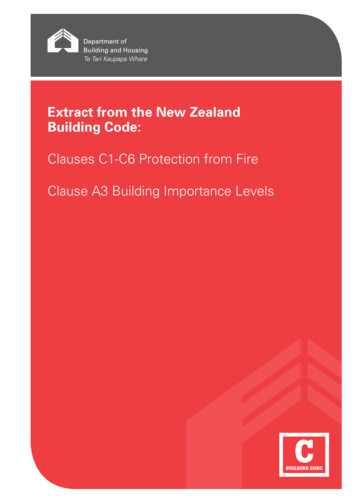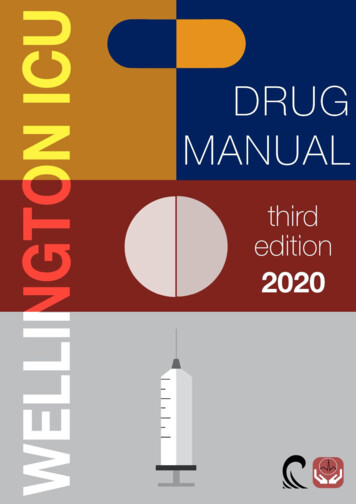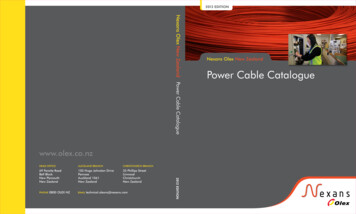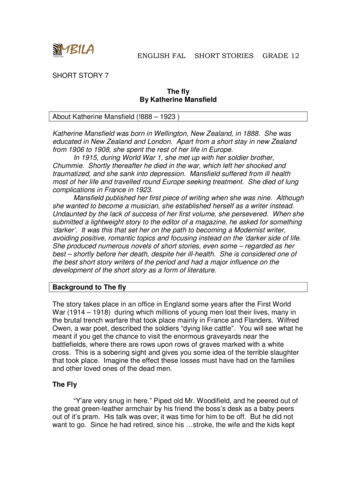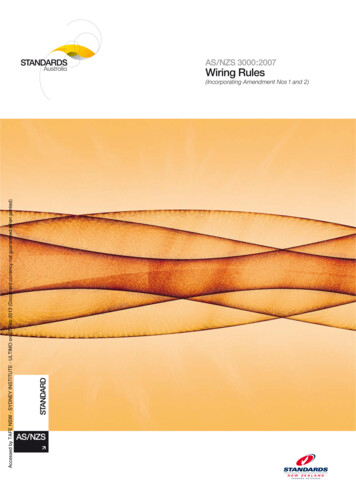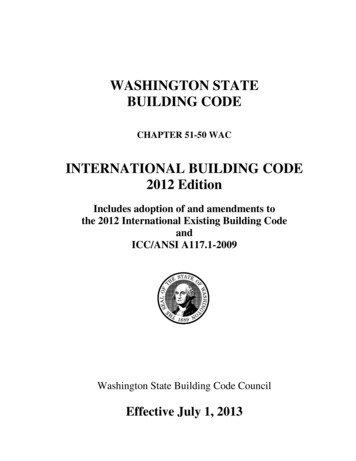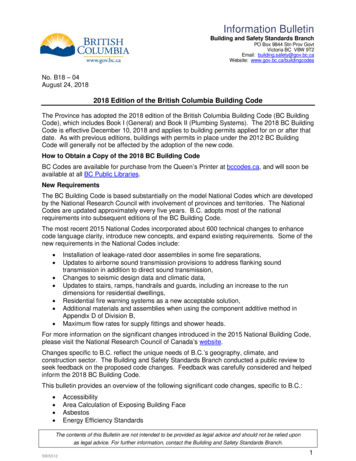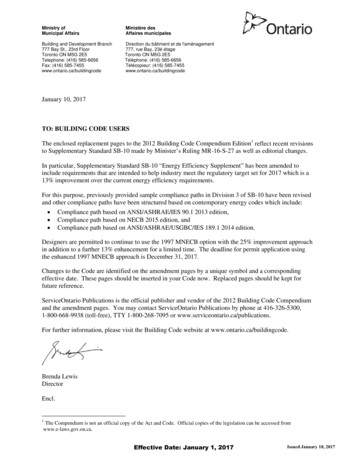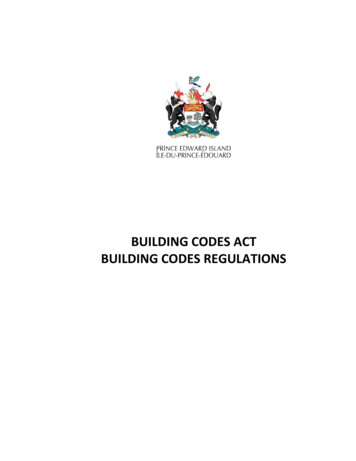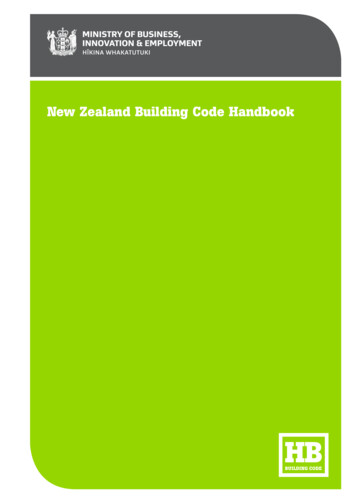
Transcription
New Zealand Building Code HandbookPrepared byby thethe MinistryMinistry ofof Business,Business, InnovationInnovation andand EmploymentEmploymentPreparedHB
Enquiries about the content of this document should be directed to:Ministry of Business, Innovation and EmploymentPO Box 1473, Wellington.Telephone 0800 242 243Fax 04 494 0290Email: info@dbh.govt.nzVerification Methods and Acceptable Solutionsare available from www.dbh.govt.nz Ministry of Business, Innovation and Employment 2014This document is protected by Crown copyright, unless indicated otherwise. TheMinistry of Business, Innovation and Employment administers the copyright in thisdocument. You may use and reproduce this document for your personal use or for thepurposes of your business provided you reproduce the document accurately and not inan inappropriate or misleading context. You may not distribute this document to othersor reproduce it for sale or profit.The Ministry of Business, Innovation and Employment owns or has licences to use allimages and trademarks in this document. You must not use or reproduce images andtrademarks featured in this document for any purpose (except as part of an accuratereproduction of this document) unless you first obtain the written permission of theMinistry of Business, Innovation and Employment.2
Document StatusThe most recent version of this document (Amendment 13), as detailed in the Document History, is approved by the ChiefExecutive of the Ministry of Business, Innovation and Employment. It is effective from 14 February 2014 and supersedes all previousversions of this document.The previous version of this document (Amendment 12) will cease to have effect on 14 August 2014.People using this document should check for amendments on a regular basis. The Ministry of Business, Innovation andEmployment may amend any part of this handbook at any time. Up-to-date versions of this handbook are available fromwww.dbh.govt.nzHandbook: Document HistoryDateAlterationsFirst publishedJuly 1992Third edition25 May 2007Amendment 11Published 31 July 2010Effective 30 September 2010pp. 6–8, 11 Prefacepp. 17–78, Code Clauses – amended and reformattedpp. 79–104A, References – amended and reprintedpp. 105–148f, Definitions – amended and reprintedpp. 150–158, 161–164, 168–170, 172, 176–178, 181,184–185 187, 189, 191, 193, 196–199, 201,204–208, IndexAmendment 12Effective from 10 October 2011until 14 August 2014p. 6, Prefacepp. 80–100, 102–104A, Referencespp. 108, 113 –115, 119–120, 122, 125 128, 136, 138, 144, 146–147,148d–f, Definitionspp. 149–208, IndexAmendment 1314 February 2014p. 2A, Document history statuspp. 3–16, Prefacepp. 17, 22–22B, 27–33C, 58Code Clause Contents, A3, C1–C6, F8pp. 79–104B, Referencespp. 105–148h, Definitionspp. 151–204 IndexNote: Page numbers relate to the document at the time of Amendment and may not match page numbers in current document.2A
2B
PrefaceNEW ZEALAND BUILDING CODE HANDBOOKPreface1.0INTRODUCTION2.01.1 This preface provides an introductionto building controls in New Zealand. Thissection shows the relationship between theNew Zealand Building Code (the Building Code)and various other Provisions that ensure buildingsin New Zealand are safe and healthy to use.1.2 The preface provides a convenient userreference. However, legal interpretation mustbe based on the actual wording of the BuildingAct 2004 (the Building Act), and amendmentsand respective Building Regulations.BUILDING CONTROL FRAMEWORKThe regulation and performance of buildingssits under the following three-part framework. The Building Act, which contains theprovisions for regulating building work. The various Building Regulations, whichcontain prescribed forms, list specifiedsystems, define ‘change the use’ and‘moderate earthquake’, and set out therate of levy and fees for determinations. The Building Code, contained in Schedule 1of the Building Regulations 1992, which setsperformance standards all new building workmust meet, and covers aspects such asstability, protection from fire, access,moisture, safety of users, services andfacilities, and energy efficiency.Amend 13Feb 2014The pyramid below illustrates the legislationthat forms the building control frameworkgoverned by the Building Act.BUILDING ACT 2004BUILDING REGULATIONSTHE NEW ZEALAND BUILDING CODEOBJECTIVEFUNCTIONAL REQUIREMENTM I N I S T RY O F BU S I N ES S , I N N OVAT I O N A N D EM P LOY M EN TPERFORMANCE14 F e b ru a r y 2 0143
NEW ZEALAND BUILDING CODE HANDBOOK2.1The Building Act 2004The Building Act provides the mandatoryframework for the building control systemto be followed when undertaking buildingwork in New Zealand. It applies to all: buildings including Crown buildings, exceptthose which may be exempt for reasons ofnational security components in a building, includingplumbing, electrical and mechanicalinstallations.The Building Act should be read taking intoaccount the changes under the BuildingAmendment Act 2005 and any subsequentamendments (copies are on www.legislation.govt.nz).2.1.1 PurposeThe Building Act aims to improve control of andencourage better practices in building designand construction to provide greater assuranceto consumers.This means: more clarity on the standards we expectbuildings to meet more guidance on how these standardscan be met more certainty that capable people areundertaking building design, constructionand inspection more scrutiny in the building consent andinspection process better protection for homeowners throughthe introduction of mandatory warranties.The purpose of the Building Act is: to provide for regulation of building work to ensure that people can use buildingssafely without endangering their health to ensure people can escape a buildingin case of fire to ensure buildings have attributes thatcontribute appropriately to the health,physical independence and wellbeingof the people who use them425 M ay 20 07Preface to ensure buildings are designed,constructed and able to be used in waysthat promote sustainable development.2.1.2 PrinciplesThe Building Act does not contain an equivalentto section 47 of the Building Act 1991 (theformer Act), which contained guidance on howa territorial authority should exercise its powers.Under section 4 of the Building Act (section 6under the former Act), principles to be appliedin performing functions or duties, or exercisingpowers under the Building Act, now havegreater importance. Section 4 should be takeninto account when performing functions, dutiesor exercising powers relating to the grantingof waivers or modifications of the BuildingCode, and the adoption and review of policieson dangerous, earthquake-prone or insanitarybuildings.The Building Act re-states many of theprinciples outlined in the former Act, and makesexplicit some of the implied principles of thatlegislation (for example, that innovation isimportant). However, some significant newconcepts have been introduced, including aparticular focus on the household unit, as wellas considering the whole-of-life costs ofbuilding work.The following is a summary of the BuildingAct principles. Household units have an important rolein the lives of the people who use them,and are accorded a special focus. The Building Code as it relates to householdunits is important, and household units needto comply with the Building Code. Maintenance requirements of householdunits need to be reasonable, and ownersof household units need to be aware of themaintenance requirements of theirhousehold units. Harmful effects on human health resultingfrom the use of building methods, products,design or building work need to be preventedor minimised.DEPARTMEN T OF BUILDING A ND HOUSING
PrefaceNEW ZEALAND BUILDING CODE HANDBOOK Buildings need to be durable.2.1.3 Application Special traditional and cultural aspectsof the intended use of a building needto be recognised.The Building Act applies to: The whole-of-life costs of a building needto be considered. maintenance of a building’s specifiedsystems, such as lifts and fire protectioninstallations. Standards are important in achievingcompliance with the Building Code forbuilding design and construction. Innovation in methods of building designand construction is important. People who undertake a rescue operationor firefighting in a building need to be ableto expect a reasonable level of protectionfrom injury or illness while doing so. The extent and effects of the spreadof fire need to be limited to protect otherhousehold units and other property. Other property needs to be protectedfrom physical damage resulting fromthe construction, use and demolitionof a building. People with disabilities need to be ableto enter and carry out normal activitiesand processes in a building. Buildings of significant cultural, historicalor heritage value need to be preserved. Energy use in buildings needs to be efficient. The use of renewable sources of energyneeds to be encouraged. Material use in buildings needs to be efficientand sustainable. Water use in buildings needs to be efficientand promote water conservation. Waste generated during the constructionprocess needs to be reduced.Amend 13Feb 2014 Owners, designers, builders and buildingconsent authorities each need to beaccountable for their role in obtainingconsents and approvals, ensuring plans andspecifications for building work will meet theBuilding Code, and ensuring work complieswith the building consent or, where a buildingconsent is not required, complies with theBuilding Code. building construction, alteration, demolitionor removalThe Building Act does not cover: planning and resource management occupational safety and health.2.1.4 StructureThe Building Act has five parts.Part 1: Contains the purpose and principlesof the Building Act, together with an overview,commencement dates for various Provisionsand definitions. These sections provide animportant reference when reading andinterpreting the Building Act.Part 2 (and Schedules 1 and 2): Outlinesmatters relating to the Building Code andbuilding control (such as building consents),including requirements of building work,requirements for the use of buildings,Provisions for certain categories of buildingsand Provisions for the safety of dams.Part 3: Sets out the functions, dutiesand powers of the Chief Executive of theDepartment of Building and Housing(the Department), territorial authorities,regional authorities and building consentauthorities. It also deals with the accreditationand registration of building consent authorities,accreditation of dam owners, and productcertification.Part 4 (and Schedule 3): Covers mattersrelating to the licensing and disciplining ofbuilding practitioners.Part 5 (and Schedule 4): Describesmiscellaneous matters, including offencesand criminal proceedings, implied termsof contracts, regulation-making powers,amendments to other enactments and therepeal of the former Act, and the transitionalProvisions from the former Act to theBuilding Act.M I N I S T RY O F BU S I N ES S , I N N OVAT I O N A N D EM P LOY M EN T14 F e b ru a r y 2 0145
NEW ZEALAND BUILDING CODE HANDBOOK2.2Building RegulationsBuilding Regulations are made under and inaccordance with the Building Act.A number of regulations have been made underthe Building Act. Currently (as at May 2007)there are seven sets of regulations.1. Building Regulations 1992, made underthe former Act and which include theBuilding Code. These regulations have beenamended by the Building (Forms)Regulations 2004 so that only certain partsremain in force. Parts still in force are:Schedule 1 (Building Code), Regulation 3,Forms 16 & 17 (and Regulation 4 andSchedule 2 where they relate tothese forms).2. Building (Forms) Regulations 2004,as amended by the Building (Forms)Amendment Regulations 2005, whichprescribes forms to be used under theBuilding Act.3. Building (Specified Systems, Changethe Use, and Earthquake-prone Buildings)Regulations 2005, as amended by theBuilding (Specified Systems, Change theUse, and Earthquake-Prone Buildings)Amendment Regulations 2005. Theseregulations outline and define thefollowing terms.Preface7. Building (Consent AuthorityAccreditation Fees) Regulations 20078. Building (Designation of Building workLicence Classes) Order 20079. Building (Design Work Declared to beBuilding Work) Order 200710. Building Practitioners (Licensing Feesand Levy) Regulations 200711. Building (Registration of BuildingConsent Authorities) Regulations 200712. Building (Infringement Offences, Fees,and Forms) Regulations 200713. Building Practitioners (Register ofLicensed Building Practitioners)Regulations 200814. Building (Dam Safety) Regulations 200815. Building Practitioners (Complaints andDisciplinary Procedures) Regulations 200816. Building (Product Certification)Regulations 200817. Building (Building Consent AuthorityTransition) Order 200818. Building (National Multiple-use Approval)Regulations 200919. Building (Minor Variations) Regulations200920. Building (Designation of Building WorkLicensing Classes) Order 2010 Specified systems – the building systemsthat must be listed on compliance schedulesand are subject to specific inspection andmaintenance procedures. Schedule 1provides the list of specified systems.21. Building Practitioners (Licensing Feesand Levy) Regulations 2010 Change the use – to determine whena change in a building’s use will requireupgrading to meet certain requirementsof the Building Act. Schedule 2 determinesthe use of all or parts of buildings.23. Canterbury Earthquake (Building Act) )Order 2010 Moderate earthquake – to definea moderate earthquake in relationto a building.22. Building Practitioners (Register ofLicensed Building Practitioners)Regulations 201024. Building (National Multiple-use Approval)Regulations 2011Note: these regulations can be foundat www.legislation.govt.nz5. Building Levy Order 20056. Building (Accreditation of BuildingConsent Authorities) Regulations 2006614 February 2014Amend 12Oct 201125.Building (Definition of Restricted BuildingWork) Order 201126.Canterbury Earthquake (Building Act)Order 2013.4. Building (Fee for Determinations)Regulations 2005Amend 11Sep 2010M I N I S T RY O F BU S I N ES S , I N N OVAT I O N A N D EM P LOY M EN TAmend 13Feb 2014
PrefaceNEW ZEALAND BUILDING CODE HANDBOOK2.32.3.2 StructureThe New Zealand Building CodeThe Building Code is contained in Schedule 1of the Building Regulations 1992. The BuildingCode contains compulsory rules for all newbuilding work.The Building Code consists of two preliminaryclauses and 37 technical clauses. Each technicalclause has three levels that describe therequirements for the clause and is listed below.2.3.1 Content1. Objective Social objectives the buildingmust achieve.The Building Code sets out performance criteriathat building work must meet. It covers aspectssuch as structural stability, fire safety, access,moisture control, durability, services andfacilities, and energy efficiency.The Building Code does not prescribe how workshould be done, but states how completedbuilding work and its parts must perform.Amend 13Feb 20142. Functional requirement Functions thebuilding must perform to meet the Objective.3. Performance The performance criteria thebuilding must achieve. By meeting theperformance criteria, the Objective andFunctional requirement can be achieved.An advantage of a performance-based BuildingCode is flexibility. It contains no prescriptiverequirements stipulating that certain productsor designs must be used. This flexibility allowsdevelopments and innovation in building design,technology and systems.Amend 11Sep 2010BUILDING ACT 2004BUILDING REGULATIONSTHE NEW ZEALAND BUILDING CODEOBJECTIVEFUNCTIONAL REQUIREMENTAmend 13Feb 2014PERFORMANCEThese paths are deemed to meet the performance requirementsof the Building Code that they coverM I N I S T RY O F BU S I N ES S , I N N OVAT I O N A N D EM P LOY M EN TIn-Service History– Standard– Technical information– Tests /researchComparison to documentComparison to Acceptable SolutionsEnergy Work CertificateProduct CertificationDeterminationNZS 4121Acceptable SolutionsVerification MethodsAlternative solutionsAmend 13Feb 2014Proposed work in this categorymust demonstrate compliance withthe performance requirements of theBuilding Code to the satisfactionof a building consent authority14 F e b ru a r y 2 0147
NEW ZEALAND BUILDING CODE HANDBOOK3.0COMPLIANCE PATHSCompliance with the Building Codecan be demonstrated using various pathways.Understanding the New Zealand building controlframework will help a building consent applicantdecide which path is most suitable whendesigning and constructing building work.The diagram below illustrates the hierarchyof New Zealand building controls, includingthe various compliance paths.The top three tiers of the pyramid (the BuildingAct and Building Regulations) show mandatorybuilding legislation that must be followed, asexplained in the previous section. The Acceptable Solutions for Clause E2External Moisture are known as E2/AS1,E2/AS2 and E2/AS3. The Verification Methods for Clause B1Structure are known as B1/VM1 and B1/VM4.3.1.1 Verification Methods laboratory tests: using tests (sometimes todestruction) on prototype components andsystemsThere is at least one Acceptable Solution orVerification Method for compliance with each ofthe Building Code clauses.For example, for Clause B1 of the Building Codethere are two Verification Methods and threeAcceptable Solutions.14 February 2014Amend 11Sep 2010Amend 12Oct 2011 The Acceptable Solution for Clause G1Personal Hygiene is known as G1/AS1.With the exception of alternative solutions,the paths illustrated on the previous page mustbe accepted by the building consent authorityas meeting the performance requirementsof the Building Code. These pathways arediscussed below.A design that complies with an AcceptableSolution or Verification Method must beaccepted by a building consent authority ascomplying with the Building Code.Amend 13Feb 2014 The Acceptable Solution for Clause G4Ventilation is known as G4/AS1.Verification Methods are tests or calculationmethods that prescribe one way to complywith the Building Code. Verification Methodscan include:Acceptable Solutions and Verification Methodsprovide details for construction that, if followed,result in compliance with the Building Code.They are published by the Ministry of Business,Innovation and Employment.8Acceptable Solutions and Verification Methodsare usually referred to by their Building Codeclauses and unique identification numbers.Some examples are listed below.The rest of the diagram shows various pathsthat may be used to demonstrate compliancewith the Building Code. Compliance with theBuilding Code must be demonstrated using oneor more of the paths. The applicant can choosewhich path(s) to follow.3.1 Acceptable Solitions and VerificationMethodsAmend 13Feb 2014Preface calculation methods: using recognisedanalytical methods and mathematical models tests-in-situ: which may involve examinationof plans and verification by test, wherecompliance with specified numbers,dimensions or locations is required (nondestructive tests, such as pipe pressuretests, are also included).3.1.2 Acceptable SolutionsThese are simple step-by-step instructionsthat show one way to comply with theBuilding Code.3.2Product certificationThe Building Act contains provisions for avoluntary product certification schemethat will enable product manufacturersto have their products certified as meetingnominated Performance requirements of theBuilding Code.Building products or methods that are used inaccordance with a product certificate as providedby section 269 of the Building Act must beaccepted as complying with the Building Code.M I N I S T RY O F BU S I N ES S , I N N OVAT I O N A N D EM P LOY M EN TAmend 11Sep 2010
PrefaceNEW ZEALAND BUILDING CODE HANDBOOK3.3offered by the Acceptable Solution orVerification Method, but achieves compliancewith the performance requirements of theBuilding Code to the satisfaction of the buildingconsent authority.Energy work certificateEnergy work is defined as gasfitting work orprescribed electrical work. An energy workcertificate certifies that energy work complieswith either the Electricity Act 1992 or theGas Act 1992.An energy work certificate must be acceptedas establishing compliance with the relevantPerformance requirements of the Building Code.3.4Amend 13Feb 20143.5DeterminationsA determination is a binding decision madeby the Department. It provides a way of solvingdisputes or answering questions relating to theBuilding Code and territorial authority/buildingconsent authority/regional authority decisionsunder the Building Act.A range of matters can be determined, including: whether a building or building work complieswith the Building Code a building consent authority’s decisionon a building consent, a notice to fix,a code compliance certificate (CCC) or acompliance schedule a territorial authority’s decision to issuea building consent subject to a waiveror modification a territorial authority’s decision on acertificate of acceptance, a complianceschedule, a notice to fix, or a certificatefor public use a regional authority’s or territorial authority’sexercise or failure to exercise its powersunder the Building Act.3.6There may be a number of reasons for the useof an alternative solution. There may not be a Acceptable Solution orVerification Method for the proposedconstruction.New Zealand Standard NZS 4121Section 119 of the Building Act specifies thatNZS 4121, the code of practice for design foraccess and use of buildings by persons withdisabilities (and any modification of that Standard),is to be taken as an Acceptable Solution.Alternative solutionsAn alternative solution is a building solution thatdiffers, in part or wholly, from the solutionsAmend 13Feb 2014Amend 13Feb 2014 The building work may incorporate unusualdesign features that fall outside the scopeof an Acceptable Solution or VerificationMethod.Amend 13Feb 2014Whatever the reason for using an alternativesolution, the Building Code, being performancebased, allows for innovation and applicants havethe freedom to propose an innovative solution.Refer to 2.3 ‘The New Zealand Building Code’.3.7Producer statementsA producer statement is a statement suppliedby or on behalf of an applicant for a buildingconsent, or by or on behalf of a personwho has been granted a building consent.It is a statement that certain work will be,or has been, carried out in accordance withcertain technical specifications.Producer statements were introduced bythe former Act and are no longer expresslyreferred to in the Building Act. A buildingconsent authority may, at their discretion,accept and consider a producer statement aspart of the plans or specifications for a buildingconsent. This will assist the building consentauthority in deciding whether it is satisfiedon reasonable grounds the provisions of theBuilding Code will be met if the building workis completed in accordance with the plans andspecifications. A building consent authorityshould have a formal procedure or policy inplace for the use and consideration of producerstatements, especially if a producerstatement(s) will be required to prove buildingwork complies with a building consent.M I N I S T RY O F BU S I N ES S , I N N OVAT I O N A N D EM P LOY M EN T14 F e b ru a r y 2 0149
NEW ZEALAND BUILDING CODE HANDBOOK4.0THE PARTIES AND THEIRRESPONSIBILITIESFive principal parties are responsible forensuring that buildings are safe and sanitaryin line with the Building Act.4.1Amend 13Feb 2014The Ministry of Business, Innovationand Employment (the Ministry)The Ministry has a range of statutoryresponsibilities for building and housing, andadministers New Zealand’s building legislation.The Ministry’s building control functionsinclude: advising the Minister for Building andConstruction on matters relating to buildingcontrol administering and reviewing theBuilding CodeAmend 13Feb 2014 producing and maintaining AcceptableSolutions and Verification Methods thatspecify a means of complying with theBuilding Code providing information, guidance, and adviceon building controls to all sectors of thebuilding industry and consumers implementing, administering and monitoringa system of regulatory controls for a vibrantsector with skilled building professionals making determinations, or technical rulings,on matters of interpretation, doubt ordispute.Preface issuing project information memoranda granting waivers or modifications of theBuilding Code (not including waivers ormodifications relating to access and facilitiesfor people with disabilities) issuing certificates of acceptance issuing certificates for public use determining the extent to which buildingsmust comply with the Building Code if theyare altered, or their use is changed or wherethere is a specified intended life change enforcing the provisions relating to annualbuilding warrants of fitness issuing certain notices provided for underthe Building Act keeping records ensuring dangerous, insanitary andearthquake prone buildings are identifiedand appropriate action taken to remove anydanger or insanitary condition amending compliance schedules carrying out other functions and dutiesspecified in the Building Act.4.3Building consent authoritiesBuilding consent authorities are responsible for: issuing building consents inspecting building work for which theygranted a building consent issuing notices to fix issuing code compliance certificates4.2 Territorial authoritiesTerritorial authorities are responsible forenforcing the Building Act, Regulations andthe Building Code in their areas of jurisdiction.They are responsible for: issuing compliance schedules and amendingthem where the specified systems areaffected by building work carrying out other functions and dutiesspecified in the Building Act. gaining accreditation as a building consentauthority registering as a building consent authority performing the functions of a buildingconsent authority1014 F e b ru a r y 2 014M I N I S T RY O F BU S I N ES S , I N N OVAT I O N A N D EM P LOY M EN T
PrefaceNEW ZEALAND BUILDING CODE HANDBOOK4.4Regional authorities are responsible for: supplying the annual building warrant offitness, if applicable performing the functions of a buildingconsent authority to the extent that thosefunctions relate to dams notifying the territorial authority if a changeof use, extension of life, or subdivision isproposed considering and approving damclassifications paying any fees as required by theBuilding Act. considering and approving dam safetyassurance programmes4.6 Licensed building practitionersRegional authorities administering the Building Act, relating todam classifications, dam safety assuranceprogrammes and dam compliancecertificates enforcing provisions of the Building Codeand the Building Act and regulations thatrelate to dams adopting a policy on dangerous dams.4.5Building ownersBuilding owners are responsible for: detailing work proposals on plans andspecifications, including proposals for theinspection and routine maintenance of thespecified systems for the purposes of thecompliance schedule (if applicable) applying for building consents(and amendments to building consents)and project information memoranda constructing buildings in accordance withthe ’approved plans and specifications’ organising inspections at given stages asbuilding work progresses collecting energy work certificates applying for a code compliance certificateas soon as any work carried out under abuilding consent granted to them iscompleted maintaining buildings in a safe andsanitary manner ensuring any specified systems in theirbuilding are performing and will continueto perform to the performance standardsThe Building Act set up a licensed buildingpractitioners (LBP) scheme to promote,recognise and support professional skillsand behaviour in the building industry. Thescheme has seven licence classes coveringdesigners, site supervisors and trades people,such as carpenters, roofers, plasterers andbricklayers.To become licensed, building practitioners mustshow they meet the standard for the licenceclass appropriate for them. Details of LBPsare held on a public register atwww.dbh.govt.nz/lbp-registerOnce licensed, LBPs are responsible fornotifying territorial authorities of breaches ofbuilding consents.Since March 2012, restricted building work onhouses and small-medium sized apartmentbuildings has only been able to be carried outor supervised by LBPs. Restricted buildingwork is design and building work that is criticalto the integrity of a house or small-mediumsized apartment building. It covers aspectsof the primary structure, external moisturemanagement and fire design.Amend 13Feb 2014Amend 13Feb 2014From March 2012: any plans and specifications containingrestricted building work (relating todesign work) must be accompanied by amemorandum issued by the LBP who carriedout or supervised the design work, statingthat the design work complies with theBuilding CodeM I N I S T RY O F BU S I N ES S , I N N OVAT I O N A N D EM P LOY M EN T14 F e b ru a r y 2 014Amend 11Sep 201011
NEW ZEALAND BUILDING CODE HANDBOOK if an application for a building consent relatesto restricted building work, the names ofthe LBPs carrying out or supervising thatwork must be given to the building consentauthority in the application (if known) oronce the work commences, or whenthe application for the code compliancecertificate is made.Amend 11Sep 2010The most up-to-date information on the LBPscheme is at www.dbh.govt.nz/lbp4.7Past building control parties4.7.1 The Building Industry AuthorityAmend 13Feb 2014The Building Industry Authority (the Authority)was a Crown entity, established under theformer Act as the sole regulatory authorityfor building controls in New Zealand. Th
performance standards all new building work must meet, and covers aspects such as stability, protection from fire, access, moisture, safety of users, services and facilities, and energy efficiency. The pyramid below illustrates the legislation that forms the building control framework governed by the Building Act. BUILDING ACT 2004

